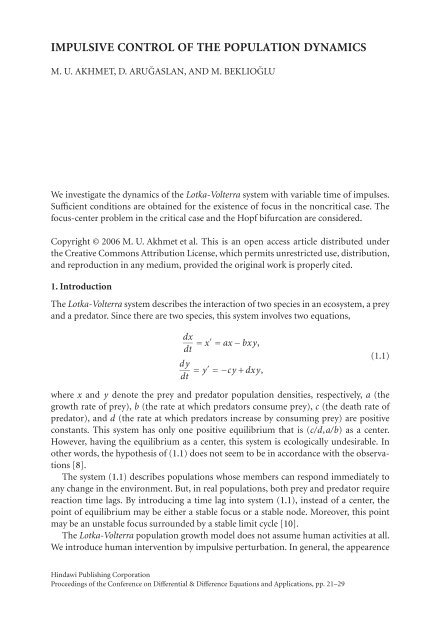DIFFERENtIAl & DIFFERENCE EqUAtIONS ANd APPlICAtIONS
DIFFERENtIAl & DIFFERENCE EqUAtIONS ANd APPlICAtIONS
DIFFERENtIAl & DIFFERENCE EqUAtIONS ANd APPlICAtIONS
Create successful ePaper yourself
Turn your PDF publications into a flip-book with our unique Google optimized e-Paper software.
IMPULSIVE CONTROL OF THE POPULATION DYNAMICS<br />
M. U. AKHMET, D. ARUĞASLAN, AND M. BEKLIOĞLU<br />
We investigate the dynamics of the Lotka-Volterra system with variable time of impulses.<br />
Sufficient conditions are obtained for the existence of focus in the noncritical case. The<br />
focus-center problem in the critical case and the Hopf bifurcation are considered.<br />
Copyright © 2006 M. U. Akhmet et al. This is an open access article distributed under<br />
the Creative Commons Attribution License, which permits unrestricted use, distribution,<br />
and reproduction in any medium, provided the original work is properly cited.<br />
1. Introduction<br />
The Lotka-Volterra system describes the interaction of two species in an ecosystem, a prey<br />
and a predator. Since there are two species, this system involves two equations,<br />
dx<br />
dt = x′ = ax − bxy,<br />
dy<br />
dt = y′ =−cy+ dxy,<br />
(1.1)<br />
where x and y denote the prey and predator population densities, respectively, a (the<br />
growth rate of prey), b (the rate at which predators consume prey), c (the death rate of<br />
predator), and d (the rate at which predators increase by consuming prey) are positive<br />
constants. This system has only one positive equilibrium that is (c/d,a/b) asacenter.<br />
However, having the equilibrium as a center, this system is ecologically undesirable. In<br />
other words, the hypothesis of (1.1) does not seem to be in accordance with the observations<br />
[8].<br />
The system (1.1) describes populations whose members can respond immediately to<br />
any change in the environment. But, in real populations, both prey and predator require<br />
reaction time lags. By introducing a time lag into system (1.1), instead of a center, the<br />
point of equilibrium may be either a stable focus or a stable node. Moreover, this point<br />
may be an unstable focus surrounded by a stable limit cycle [10].<br />
The Lotka-Volterra population growth model does not assume human activities at all.<br />
We introduce human intervention by impulsive perturbation. In general, the appearence<br />
Hindawi Publishing Corporation<br />
Proceedings of the Conference on Differential & Difference Equations and Applications, pp. 21–29

















